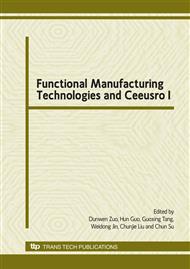p.220
p.225
p.230
p.235
p.240
p.245
p.249
p.254
p.260
Micro/Nano Functional Manufacturing: From Microthruster to Nano Energetic Material to Micro/Nano Initiator
Abstract:
Functional manufacturing technologies are becoming more and more important to the manufacturing industry and research. As promising categories of functional manufacturing, micro and nano manufacturing have received steadily growing interests in recent years. In this paper, as typical examples to demonstrate micro and nano manufacturing, our work on microthruster, nano energetic material, and micro/nano initiator is presented. Microspacecraft is one application of microsystem in space. In a microspacecraft, a micropropulsion system is required for station keeping, attitude control, and orbit adjust. New silicon and ceramic microthrusters are described. Energetic materials including propellants, explosives, and pyrotechnics have found diverse applications. Nano energetic materials (nEMs) have improved performances in energy release, ignition, and mechanical properties compared to their bulk/micro counterparts. A novel nano Al and CuO nanowire based nEM is discussed. Electro-explosive devices (EEDs) activated by electrical energy are used to initiate an explosive, burning, electrical, or mechanical train. EEDs have found numerous applications in triggering the inflation of airbags in automobiles, micropropulsion, and arm fire/safe devices for ordnance systems. An innovative EED is developed by integrating Al/CuO based nEM with a Au/Pt/Cr micro heater on a substrate.
Info:
Periodical:
Pages:
240-244
Citation:
Online since:
January 2010
Authors:
Price:
Сopyright:
© 2010 Trans Tech Publications Ltd. All Rights Reserved
Share:
Citation:


